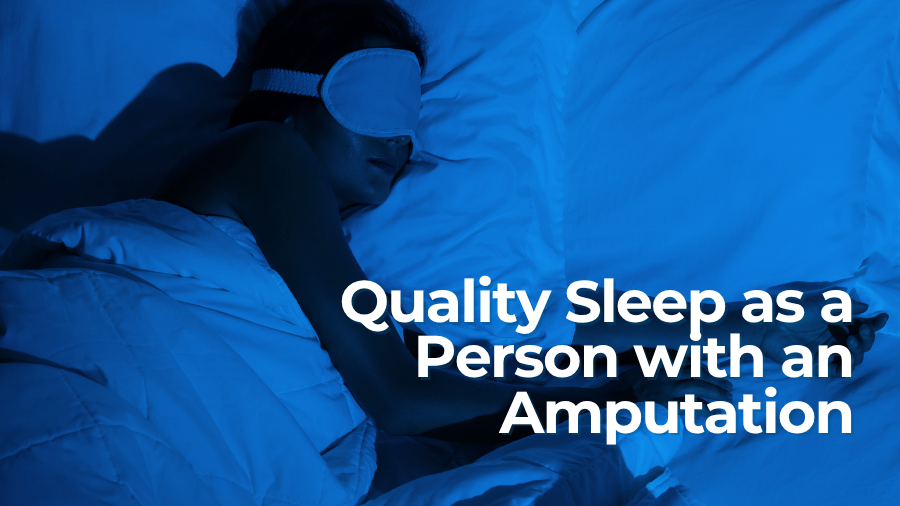
Sleep is essential for our physical, emotional, and mental well-being. But for individuals with limb loss, getting a good night's sleep can be particularly challenging due to issues like phantom limb pain, residual limb discomfort, and changes in mobility.
In this article, we will explore practical sleep tips for amputees, including strategies to improve comfort, reduce nighttime pain, and establish better sleep habits.
Invest in a Comfortable, Supportive Mattress
One of the simplest yet most impactful changes you can make is upgrading your mattress. A good-quality mattress helps reduce pressure points and supports healthy spinal alignment, both of which are important for people with prosthetics or residual limbs. Look for a mattress that:
- Offers medium-firm support.
- Reduces pressure on the hips, shoulders, and limbs.
- Has good motion isolation (helpful if you sleep with a partner).
Managing Phantom Limb Pain at Night
Phantom limb pain is a common and often frustrating challenge for amputees, especially at night when distractions are minimal. Here are a few tips for managing phantom pain during sleep:
- Wear a shrinker sock or compression garment to gently compress the residual limb.
- Use heat or cold therapy cautiously (consult your clinician first).
- Talk to your doctor about medications or therapies, including mirror therapy or TENS.
- Massage your residual limb before bed to relax tense muscles and nerves.
- Avoid stimulants like caffeine and nicotine before sleep, as they can increase nerve sensitivity.
Prevent Muscle Cramps in the Residual Limb
Cramping can significantly disrupt sleep and often affects the residual limb. To reduce the likelihood of cramps:
- Stay well-hydrated throughout the day.
- Eat potassium-rich foods like bananas, potatoes, citrus fruits, red meat, and fish.
- Stretch or gently massage your limb before bed to relax the muscles. Take a look here for tips on stretching.
Practice Good Sleep Hygiene
Sleep hygiene refers to the habits and environment that help promote restful sleep. For people with limb loss, consistent routines can make a big difference. Here are some sleep hygiene best practices:
- Stick to a regular sleep schedule, even on weekends.
- Keep your bedroom cool, quiet, and dark.
- Avoid screen time at least 30–60 minutes before bed.
- Limit caffeine, nicotine, and alcohol, especially in the evening.
- Reserve your bed for sleep—not for scrolling or TV.
Consider a Weighted Blanket for Comfort
Weighted blankets are increasingly popular for promoting relaxation and improving sleep quality. The gentle pressure can:
- Soothe anxiety
- Help regulate breathing and heart rate
- Encourage deeper, uninterrupted sleep
Some individuals with limb loss find the added pressure calming—just be sure to choose a blanket that’s no more than 10% of your body weight and won’t interfere with your prosthesis or residual limb comfort.
Try Relaxation Techniques to Ease into Sleep
Managing stress and anxiety is just as important as managing physical discomfort. Many amputees experience emotional strain following limb loss, which can interfere with sleep. Relaxation strategies that can help include:
- Deep breathing exercises
- Progressive muscle relaxation
- Meditation or mindfulness
- Guided imagery or calming music
- Yoga or gentle stretching
There are many free apps (like Calm, Insight Timer, or Headspace) that offer sleep-focused sessions.
Bonus Tip: Wear Your Prosthesis Early in the Day
If your prosthesis is safe and comfortable to wear in the morning, try putting it on as soon as you get out of bed. Doing so can help reduce fluid build-up in the residual limb—a common issue after lying down—and may make it easier to wear your prosthesis later in the day. This simple habit can also contribute to improved overall comfort and mobility throughout your daily activities.
Talk to Your Healthcare Team About Ongoing Sleep Challenges
If you continue to struggle with sleep despite making these adjustments, it's important to speak with your healthcare provider, prosthetist, or occupational therapist. They can help identify underlying issues and recommend additional support, which may include medication adjustments, custom orthotic solutions, mental health counseling, or connecting you with support groups for individuals living with limb loss. These resources can make a meaningful difference in both your sleep quality and overall well-being.
Getting quality sleep after limb loss can be difficult, but with the right strategies, it is possible. From managing phantom limb pain to creating a restful bedtime routine, these tips can help amputees get the restorative sleep they need to heal, recover, and thrive.
Related Resources
4 Tips for Better Sleep with an Amputation – Movao
Tips for Better Sleep with Your Prosthesis – BioAdvance O&P
